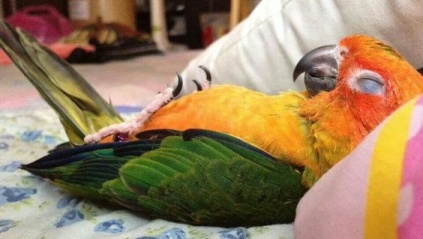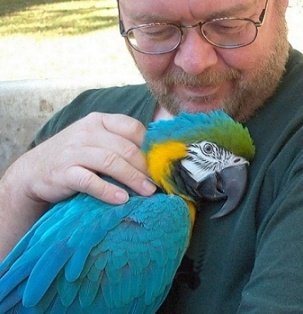So You Want To Get A Bird?
Take A DEEP Breath!
So, you’ve decided you want a bird. You’d like to have some cheerful bird music, little twitters and chirps as the background sounds in your home. You imagine your bird as a pretty little thing, in a cute little cage, perhaps coming out now and then and sitting on your finger or shoulder as you wander around your home. A little companion…or perhaps a larger companion. Either way, before you jump into bird ownership, there are some issues and questions you literally MUST address.
Before we even get into what kind of bird, you have to look around at your environment to determine if it’s gonna be safe to have a bird in your home. Trust me, when you bring a bird into your home, you remove a LOT of other stuff from the environment. Birds are delicate. They are incredibly sensitive to the environment they’re in. So, you must make your home, which will be their entire universe, safe and secure for them. Simply put, if you don’t do this, your bird will almost certainly die.
Some of the dangers are obvious, some are so hidden that you might not even realize there’s a hazard until it’s too late.
Let’s start with the air quality. Birds literally breathe with their entire bodies. It’s often said that a bird’s bones are “hollow.” That’s not entirely true. They are POROUS, more than being simply hollow. There’s an incredible structure in bird bones. Lightweight yet so very strong. When a bird takes a breath, the air goes into the lungs, but it also goes into the bones and is distributed to the entire body. So, any contaminants, poisons, gases or hazardous fumes are literally absorbed immediately into the bird’s ENTIRE body.
Years ago, when mining was a tremendously gruelling and dangerous business, the air quality in mines would often become toxic and miners would be overcome before realizing there was a problem. Ventilation was poor and there were few instruments to measure the toxicity of the air the miners breathed in those deep dark shafts.
Enter the canary. The delicate and beautiful canary was the main warning device that miners had. When they went down into the mine, so did the canaries. As the miners worked, they’d keep an eye on the canary in the cage. As long as the canary was OK, so were they. But, if the canary suddenly dropped from its perch, the miners knew it was time to cut a trail and get GONE from that shaft.
Why? All comes down to the avian respiratory system. That “whole body” breathing means that anything toxic is absorbed by the entire body at virtually the same time. If the air quality dropped significantly, the canary dropped to the bottom of its cage, dead. That was the signal that the air had gone bad and the next thing to drop would be the miners. It's safe to say human lives were spared because of the "canary in the coal mine."
The average American home, believe it or don’t, can have more toxic fumes in it than the shafts of a coal mine. We’ve become used to them and we even introduce some of them deliberately, not knowing that we’re endangering the very lives of our winged companions.
Cookware, for example. Teflon, under whatever name it is distributed, is DEADLY to birds. Even the slightest overheating of a non-stick cooking surface releases noxious fumes. We might not smell them, but they are instantly fatal to birds. No warning. No symptoms. No treatment. The bird just dies. A particularly cruel death, in fact.
So, bringing a bird in the front door means ALL your non-stick cooking surfaces should go out the back door. That’s a tough decision and it’s costly to replace virtually every pot and pan in your kitchen. I can only say the danger is very real and you won’t know it’s dangerous until your bird collapses.
And, it’s not just cookware. I know of a large zoo that lost some very rare and valuable birds when they unknowingly put a warming lamp in an exotic bird aviary. The shield was coated with a non-stick coating, which emitted toxic fumes when the lamp got hot. After a cold night, the staff found over 20 dead birds in the aviary the next morning. That heat lamp heated the shield, which then emitted deadly fumes, which killed the birds. There’s dozens of similar stories, all ending the same way. Once exposed, there is no treatment, no cure…only a dead bird.
Now, we find non-stick technology in so many different products and supplies. There’s even Teflon in toilet bowl cleaner or floor waxes. It’s HARD to make your home completely safe from the non-stick compounds so commonly used in the things we routinely use every day. Hard, but not impossible.
Which also means none or only bird safe candles, all cotton wicks, no metal. No incense, no room sprays, no Plug-Ins, no perfume, no aerosols such as the fabric fresheners. No smoking in the home absolutely. I’ve stopped using after shave or cologne. We use our fireplace very carefully. We look at labels and avoid anything that even resembles “non-stick.”
Therefore, the FIRST question to ask yourself if considering a bird is simple. Are you willing to make the fundamental changes in your world so it’ll be safe for a bird? If the answer is “no,” then I urge you to find another pet. Do NOT buy a bird.
If you ARE willing to make modifications to your life and lifestyle so you can enjoy the companionship of a bird, then good for you!!!
The way I figure it is this. Regardless of the source, if it’s toxic to birds, it is also toxic to ME! Might be a the sub-clinical level and it might take years to accumulate in my body, but, bottom line, the fewer toxins I absorb from fumes, smoke or vapors, the better off I am. Same for the other critters in our home. A few less carcinogenic compounds is bound to be a GOOD thing, right?
More later.
Be talkin’ to you……………………..Web Rydr




Hallo @webrydr nice post, i like it. I will follow your account please follow me and Upvote @sanu